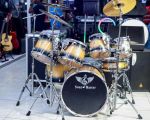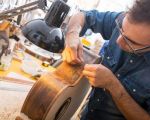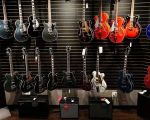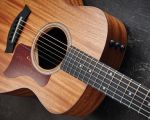What Instruments Are Used in Hip Hop Music
Hip hop music, since its emergence in the late 1970s, has become one of the most influential genres in the world. Its signature sound, a mix of rhythmic beats and raw lyrical flow, has captivated listeners of all ages. But what exactly goes into making a hip hop track? You might be surprised to know that hip hop music utilizes a variety of instruments, both traditional and electronic, to create those unforgettable sounds. Whether you're a seasoned producer or a curious listener, understanding the instruments behind hip hop music can enhance your appreciation of the genre. Let’s dive into the key instruments used in creating hip hop beats.
1. Drum Machines – The Backbone of Hip Hop Beats
When you think of hip hop, one of the first things that come to mind is the beat. And no instrument is more synonymous with hip hop beats than the drum machine. These machines, which have evolved over the years, are at the heart of most hip hop tracks. The Roland TR-808, introduced in the 1980s, is arguably the most iconic drum machine used in hip hop. Its booming bass and crisp snares have shaped the sound of countless hip hop hits.
Drum machines are prized for their ability to create rhythmic patterns, beats, and loops that form the foundation of a track. Today’s producers use modern drum machines and digital audio workstations (DAWs) to create more intricate and customized beats. Machines like the Akai MPC, which allows producers to sample sounds and manipulate them, have revolutionized hip hop production.
2. Turntables – Scratching and Sampling
In the early days of hip hop, turntables were just as essential as drum machines. DJs used turntables to scratch records, manipulate sound, and create new music out of existing tracks. This technique, known as scratching, involves manually moving a vinyl record back and forth to create rhythmic sounds that complement the music.
Sampling is another critical aspect of hip hop. Producers often take short segments of existing songs—like a beat, a vocal line, or an instrumental riff—and incorporate them into new tracks. This process has its roots in the art of turntablism, where DJs would sample music from old vinyl records and rework them. Today, digital samplers have replaced vinyl, but the essence of sampling remains a core aspect of hip hop production.
3. Synthesizers – Creating Unique Sounds
Synthesizers are another key instrument used in hip hop music, particularly for creating atmospheric sounds and melodies. Synths can generate a wide range of tones and textures, from warm, mellow pads to sharp, high-pitched leads. They are often used in hip hop to craft melodies that complement the rhythmic beat, adding depth and character to the track.
Some of the best-known hip hop tracks, especially from the 90s and early 2000s, feature iconic synthesizer riffs. For instance, Dr. Dre’s productions often incorporate synths to create smooth, atmospheric vibes. Modern synths are digital and come in various forms, with many producers using software synthesizers in DAWs to create custom sounds that fit the mood of the track.
4. Bass Guitars – Adding Groove and Depth
The bass guitar, though more common in rock and funk music, plays a pivotal role in some hip hop tracks. Basslines provide the groove that gives the song its driving rhythm and energy. In certain subgenres of hip hop, like West Coast hip hop, bass guitars are essential for creating that deep, laid-back feel. The bass helps to anchor the beat, giving it a more organic and soulful vibe.
While many hip hop tracks rely on synthetic bass created by drum machines or synthesizers, live bass guitar performances can bring a certain depth and texture that artificial instruments can’t replicate. Hip hop artists like Kendrick Lamar and A Tribe Called Quest often incorporate live instruments like bass guitars to achieve a more authentic, full-bodied sound.
5. Keyboards – Melodic Elements and Chords
Keyboards, whether in the form of electric pianos or traditional organs, are commonly used in hip hop for adding melodies, chords, and harmonies to a track. While some producers prefer the warmth of live instruments, many modern producers use digital keyboards within their DAWs to craft intricate melodies that elevate their beats.
In hip hop, keyboards can provide lush background textures or take the spotlight in certain tracks. For example, the smooth, jazzy piano samples in many of Jay-Z’s and Kanye West’s tracks add richness and complexity to the beats. Keyboards are also often used in live performances, with many hip hop groups bringing them on stage for a fuller, more dynamic sound.
6. Percussion Instruments – Adding Layers and Complexity
Hip hop producers frequently incorporate various percussion instruments to add complexity and texture to their tracks. These can include traditional drums, congas, bongos, and even unconventional items like pots and pans. Percussion is often used to create interesting fills, breaks, and transitions within a song, helping to maintain energy and momentum throughout the track.
For instance, many producers incorporate ethnic percussion instruments to give their beats a global or world music feel. This fusion of different styles helps keep hip hop fresh and exciting, bringing in influences from all over the world. The rhythmic layers provided by percussion instruments give hip hop tracks a dynamic and evolving texture.
7. Vocals and Voice Manipulation
While not traditionally considered an "instrument," vocals are a crucial component of hip hop. In many ways, the human voice is one of the most versatile "instruments" in hip hop music. Rappers use their voices to weave complex rhymes, tell stories, and create a rhythm that complements the beat. Beyond traditional rapping, vocal manipulation and effects are often used to add variety to the sound.
Producers also use software to alter and manipulate vocals, creating harmonies, background effects, or distorted samples that add depth to the track. Vocal chops and hooks are often manipulated to create catchy loops or hooks that reinforce the theme of the song.
8. Conclusion: The Future of Hip Hop Instruments
The world of hip hop is ever-evolving, and so are the instruments used to create it. With the advent of technology, many of the traditional instruments are being replaced or augmented by digital tools. However, the essence of hip hop—its rhythm, creativity, and energy—remains the same. Whether it’s the soulful thump of a bass guitar, the booming sound of a drum machine, or the smooth flow of a synthesizer, the right combination of instruments can help create the perfect hip hop track.
If you’re a budding producer or a curious listener, understanding the instruments behind the beats can deepen your appreciation of the genre. Experimenting with these instruments or learning how to use them in your own productions can open up a world of creativity. Hip hop continues to evolve, and with the right instruments, you can be part of that journey!








